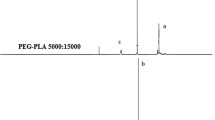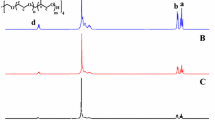Abstract
Polymersomes are polymer-based vesicles that form upon hydration of amphiphilic block copolymers and display high stability and durability, due to their mechanical and physical properties. They have hydrophilic reservoirs as well as thick hydrophobic membranes; allowing to encapsulate both water-soluble bioactive agent and hydrophobic drugs. In this study, poly ethylene glycol (PEG3350 and PEG6000) were used as hydrophilic part and poly(vinyl benzoate) (PVBz) as hydrophobic block to synthesize amphiphilic triblock copolymers (PVBz-b-PEG-b-PVBz). Different proportions of hydrophilic/hydrophobic part were assayed in order to obtain polymersomes by solvent injection method. For the synthesis of the copolymers, the initial block of PEG was derived to obtain a macroinitiator through a xanthate functional group (PEGX3 or PEGX6) and the polymerization of vinyl benzoate was carried out through reversible addition-fragmentation chain transfer polymerization (RAFT). The structure of PEGX and copolymers was confirmed by Infrared, 1H-NMR and UV-Vis spectrometry, while the average molecular weight (Mw) and polydispersity index (PI) were determined by size exclusion chromatography (SEC). The structures adopted by the copolymers in aqueous solution by self-assembly were investigated using transmission electron microscopy (TEM), dynamic light scattering (DLS) and small-angle X-ray scattering (SAXS). Both techniques confirm that polymersomes were obtained for a fraction of hydrophilic block (f) ≈ 35 ± 10%, with a diameter of 38.3 ± 0.3 nm or 22.5 ± 0.7 nm, as determined by TEM and according to the M w of the precursor block copolymer. In addition, we analyzed the possible cytotoxicity in view of its potential application as biomedical nanocarrier. The results suggest that polymersomes seem not induce cytotoxicity during the periods of time tested.










Similar content being viewed by others
References
Alibolandi M, Ramezani M, Abnous K, Sadeghi F, Hadizadeh F (2015) Comparative evaluation of polymersome versus micelle structures as vehicles for the controlled release of drugs. J Nanopart Res 17:76–91
Bain J, Berry ME, Dirks CE, Staniland SS (2015) Synthesis of ABA tri-block co-polymer magnetopolymersomes via electroporation for potential medical application. Polymers 7:2558–2571
Blanazs A, Armes SP, Ryan AJ (2009) Self-assembled block copolymer aggregates: from micelles to vesicles and their biological applications. Macromol Rapid Commun 30:267–277
Branca C, Magazù S, Maisano G, Migliardo F, Migliardo P, Romeo G (2002) Hydration study of PEG/water mixtures by quasi elastic light scattering, acoustic and rheological measurements. J Phys Chem B 106:10272–10276
Brinkhuis RP, Rutjes FPJT, van Hest JCM (2011) Polymeric vesicles in biomedical applications. Polym Chem 2:1449–1462
Christian DA, Cai S, Bowen DM, Kim Y, Pajerowski JD, Discher DE (2009) Polymersome carriers: from self-assembly to siRNA and protein therapeutics. Eur J Pharm Biopharm 71:463–474
Colley HE, Hearnden V, Avila-Olias M, Cecchin D, Canton I, Madsen J, MacNeil S, Warren N, Hu K, McKeating JA, Armes SP, Murdoch C, Thornhill MH, Battaglia G (2014) Polymersome-mediated delivery of combination anticancer therapy to head and neck cancer cells: 2D and 3D in vitro evaluation. Mol Pharm 11:1176–1188
Cortizo AM, Ruderman G, Correa G, Mogilner IG, Tolosa EJ (2012) Effect of surface topography of collagen scaffolds on cytotoxicity and osteoblast differentiation. J Biomater Tissue Eng 2:125–132
Davidson GS, Terbrugge KG (1995) Histologic long-term follow-up after embolization with polyvinyl alcohol particles. Am J Neuroradiol 16:843–846
Discher DE, Ahmed F (2006) Polymersomes. Annu Rev Biomed Eng 8:323–341
Discher DE, Eisenberg A (2002) Polymer vesicles. Science 297:967–973
García-Juan H, Nogales A, Blasco E, Martínez JC, Šics I, Ezquerra TA, Piñol M, Oriol L (2016) Self-assembly of thermo and light responsive amphiphilic linear dendritic block copolymers. Eur Polym J 81:621–633
Gradzielski M, Langevin D, Magid L, Strey R (1995) Small-angle neutron scattering from diffuse interfaces. 2. Polydisperse shells in water-n-alkane-C10E4 microemulsions. J Phys Chem 99:13232–13238
Guinier AF, Fournet G (1955) Small angle scattering of X-rays. Wiley, New York
Habel J, Ogbonna A, Larsen NW, Cherré S, Kynde S, Midtgaard SR, Kinoshita K, Krabbe S, Jensen GV, Hansen JS, Almdal K, Helix-Nielsen C (2015) Selecting analytical tools for characterization of polymersomes in aqueous solution. RSC Adv 5:79924–79946
Harris JM, Chess RB (2003) Effect of pegylation on pharmaceuticals. Nat Rev Drug Discov 2:214–221
Johnston AH, Dalton PD, Newman TA (2010) Polymersomes, smaller than you think: ferrocene as a TEM probe to determine core structure. J Nanopart Res 12:1997–1200
Kline SR (2006) Reduction and analysis of SANS and USANS data using IGOR pro. J App Crystallography 39:895–900
Labruère R, Sicard R, Cormier R, Turos E, West L (2010) Poly(vinyl benzoate) nanoparticles for molecular delivery: studies on their preparation and in vitro properties. J Control Release 148:234–240
Lastra ML, Molinuevo MS, Cortizo AM, Cortizo MS (2017) Fumarate copolymer-chitosan cross-linked scaffold directed to osteochondrogenic tissue engineering. Macromol Biosci 17. https://doi.org/10.1002/mabi.201600219
Lee JS, Feijen J (2012) Polymersomes for drug delivery: design, formation and characterization. J Control Release 161:473–483
Li Z, Tan BH (2014) Towards the development of polycaprolactone based amphiphilic block copolymers: molecular design, self-assembly and biomedical applications. Mat Sci Eng C 45:620–634
Lipscomb CE, Mahanthappa MK (2009) Poly(vinyl ester) block copolymers synthesized by reversible addition-fragmentation chain transfer polymerizations. Macromolecules 42:4571–4579
Lipscomb CE, Mahanthappa MK (2011) Microphase separation mode-dependent mechanical response in poly(vinyl ester)/PEO triblock copolymers. Macromolecules 44:4401–4409
Liu G, Ma S, Li S, Cheng R, Meng F, Liu H, Zhong Z (2010) The highly efficient delivery of exogenous proteins into cells mediated by biodegradable chimaeric polymersomes. Biomaterials 31:7575–7585
Lopez-Oliva AP, Warren NJ, Rajkumar A, Mykhaylyk OO, Derry MJ, Doncom KEB, Rymaruk MJ, Armes SP (2015) Polydimethylsiloxane-based diblock copolymer nano-objects prepared in nonpolar media via RAFT-mediated polymerization-induced self-assembly. Macromolecules 48:3547–3555
LoPresti C, Lomas H, Massignani M, Smart T, Battaglia G (2009) Polymersomes: nature inspired nanometer sized compartments. J Mater Chem 19:3576–3590
Mai Y, Eisenberg A (2012) Self-assembly of block copolymers. Chem Soc Rev 41:5969–5985
Meng F, Zhong Z (2011) Polymersomes spanning from nano- to microscales: advanced vehicles for controlled drug delivery and robust vesicles for virus and cell mimicking. J Phys Chem Lett 2:1533–1539
Mosqueira VC, Legrand P, Gulik A, Bourdon O, Gref R, Labarre D, Barratt G (2001) Relationship between complement activation, cellular uptake and surface physicochemical aspects of novel PEG-modified nanocapsules. Biomaterials 22:2967–2979
Nardin C, Hirt T, Leukel J, Meier W (2000) Polymerized ABA triblock copolymer vesicles. Langmuir 16:1035–1041
Onaca O, Enea R, Hughes DW, Meier W (2009) Stimuli-responsive polymersomes as nanocarriers for drug and gene delivery. Macromol Biosci 9:129–139
Pippa N, Pispas S, Demetzos C (2016) Polymer self-assembled nanostructures as innovative drug nanocarrier platforms. Curr Pharm Des 22:2788–2795
Roy D, Sumerlin BS (2011) Block copolymerization of vinyl ester monomers via RAFT/MADIX under microwave irradiation. Polymer 52:3038–3045
Scherer M, Kappel C, Mohr N, Fischer K, Heller P, Forst R, Depoix F, Bros M, Zentel R (2016) Functionalization of active Ester-based polymersomes for enhanced cell uptake and stimuli-responsive cargo release. Biomacromolecules 17:3305–3317
Torchilin VP (2012) Multifunctional nanocarriers. Adv Drug Deliv Rev 64:302–315
Woodle MC (1995) Sterically stabilized liposome therapeutics. Adv Drug Deliv Rev 16:249–265
Working PK (1997) Safety of poly(ethylene glycol) and poly(ethylene glycol) derivatives. In Poly(ethylene glycol)chemistry and biological applications, eds Harris JM, Zalipsky S, (ACSC, Symposium Series 680) Ch 4, pp 45–57
Yamaoka T, Tabata Y, Ikada Y (1994) Distribution and tissue uptake of poly(ethylene glycol) with different molecular weights after intravenous administration to mice. J Pharm Sci 83:601–606
Zelikin AN, Price AD, Stadler B (2010) Poly(methacrylic acid) polymer hydrogel capsules: drug carriers, sub-compartmentalized microreactors, artificial organelles. Small 6:2201–2207
Zhang L, Eisenberg A (1996) Multiple morphologies and characteristics of “crew-cut” micelle-like aggregates of polystyrene-b-poly(acrylic acid) diblock copolymers in aqueous solutions. J Am Chem Soc 118:3168–3181
Acknowledgements
LNB is a fellowship of CONICET, AMC is a member of the Carrera del Investigador Científico CICPBA, and PP and MSC are members of the Carrera del Investigador CONICET and Professors of UNLP.
Funding
This research was partially supported by grants from the Facultad de Ciencias Exactas, Universidad Nacional de La Plata (UNLP, 11/X768 and 11/X769), Comisión de Investigaciones Científicas de la Provincia de Buenos Aires, Consejo Nacional de Investigación Científicas y Técnicas (CONICET) (PIP-D0047), and LNLS (Brazilian Synchrotron Light Laboratory, Brazil—proposal 20170091).
Author information
Authors and Affiliations
Ethics declarations
Conflict of interest
The authors declare that they have no conflicts of interests.
Electronic supplementary material
ESM 1
(PDF 205 kb)
Rights and permissions
About this article
Cite this article
Besada, L.N., Peruzzo, P., Cortizo, A.M. et al. Preparation, characterization, and in vitro activity evaluation of triblock copolymer-based polymersomes for drugs delivery. J Nanopart Res 20, 67 (2018). https://doi.org/10.1007/s11051-018-4169-7
Received:
Accepted:
Published:
DOI: https://doi.org/10.1007/s11051-018-4169-7




